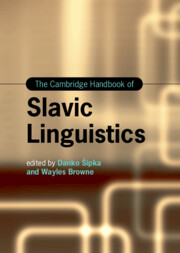Book contents
- The Cambridge Handbook of Slavic Linguistics
- Cambridge Handbooks in Language and Linguistics
- The Cambridge Handbook of Slavic Linguistics
- Copyright page
- Contents
- Figures
- Tables
- Contributors
- Introduction
- Part 1 Prosody and Phonology
- Part 2 Inflectional and Derivational Morphology
- 7 Inflectional Endings: Declensions
- 8 Inflectional Endings: Conjugation
- 9 Tense and Mood Forms
- 10 Aspect in Verbs
- 11 Lexical Derivation
- 12 Lexical Composition
- Part 3 Syntax
- Part 4 Lexicon
- Part 5 Sociolinguistic and Geographical Approaches
- Part 6 Experimental and Quantitative Approaches
- Name Index
- Subject Index
- References
12 - Lexical Composition
from Part 2 - Inflectional and Derivational Morphology
Published online by Cambridge University Press: 16 May 2024
- The Cambridge Handbook of Slavic Linguistics
- Cambridge Handbooks in Language and Linguistics
- The Cambridge Handbook of Slavic Linguistics
- Copyright page
- Contents
- Figures
- Tables
- Contributors
- Introduction
- Part 1 Prosody and Phonology
- Part 2 Inflectional and Derivational Morphology
- 7 Inflectional Endings: Declensions
- 8 Inflectional Endings: Conjugation
- 9 Tense and Mood Forms
- 10 Aspect in Verbs
- 11 Lexical Derivation
- 12 Lexical Composition
- Part 3 Syntax
- Part 4 Lexicon
- Part 5 Sociolinguistic and Geographical Approaches
- Part 6 Experimental and Quantitative Approaches
- Name Index
- Subject Index
- References
Summary
This chapter presents the patterns of composition in Slavic languages. In Slavic, most compounds are nouns (like čel-o-věkъ) and adjectives (like *bos-o-nògъ). Verbal compounds (like blag-o-sloviti ‘to bless’) are less frequent and less productive (as is generally the case in Indo-European languages). The author reviews patterns and phenomena of nominal, adjectival, adverbial, verbal, pronominal, and numeral composition.
- Type
- Chapter
- Information
- The Cambridge Handbook of Slavic Linguistics , pp. 245 - 260Publisher: Cambridge University PressPrint publication year: 2024



